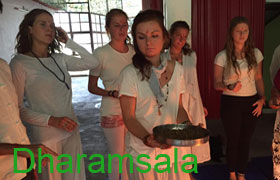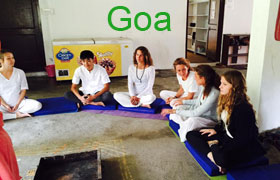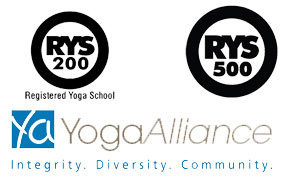Asanas that Strengthen Abdomen (Stomach)
Makaraasana
Procedure
Makara Asana can be practiced in various styles. We discuss about a simple and easy posture here.
1. Lie down of the floor on your stomach.
2. Keep both of your feet one and half to two feet apart.
3. Ankles should be turned inwards while the toes should be facing outwards.
4. Keep your right palm on your left palm and rest your head on them. Lie down in a relaxed posture.
Benefits
1. This posture of makara asana is aimed for relaxation. Hence this asana relieves us from physical and mental stress.
2. It provides mental peace.
Precautions
1. This asana should not be practiced for long time if you are affected with high blood pressure.
Niralamba Asana
Procedure
1. Place both of feet together and toes of your feet on the ground.
2. Keep both of your elbows one foot distant from each other and place your palms on your cheeks. Keep your head raised up.
Benefits
Beneficial for cervical, spondylitis, back ache, asthma and indigestion.
Precautions
This asana should not be practiced when affected with hernia.
Ardha Salbhasana
Procedure
1. Lie down on your stomach on the floor. Place your chin on the floor. Keep both of your legs together with your toes towards the floor. Keep your fists close to your thighs.
2. Inhale air into your chest and raise one of your legs gradually upwards. You should not raise your buttocks while raising your leg up.
3. Pause for a while in this posture and gradually drop your leg on to the floor.
4. In same way, the other leg also should be raised and paused for a while in that posture. Then gradually drop the leg on to the floor.
Salabhasana
This posture looks similar to a grass hopper. Salabha in Sanskrit means grasshopper. Thus it is called salabhasana
Procedure
1. Both the legs are raised upwards together while inhale the air into the chest. Pause in this state for a while and then drop your legs on to floor slowly. The remaining procedure is similar to that of the ardha salabhasana.
Benefits
1. Beneficial for sciatica and constipation.
2. This asana strengthens the lungs.
3. Strengthens shank and thigh muscles.
4. It will influence ovaries and uterus.
Precautions
This asana should not be practiced when affected with hernia, high blood pressure and appendicitis.
Samanvayatmak Asana
Procedure
1. Lie down on the floor on your stomach. Inhale air in and raise your left leg and right hand upwards.
2. Pause in this posture for a while and drop them slowly on to the floor. Now raise left hand and right leg upwards.
3. Pause in this posture for a while and drop them slowly on to the floor.
Benefits
1. This asana brings balance into your mind and body.
2. Highly influences the functionality of kidneys.
The yoga teacher training program in Goa specially dedicates few schedules to train the trainees with all these asanas
Vipareet Nauka Asana
Procedure
1. Inhale air in and rise both of your hands and legs upwards in the shape of a boat.
2. Pause for a while in this posture and revert to original state gradually.
Benefits
1. Works very well on hip, neck and shoulder related pains.
2. Makes your spinal cord flexible and relieves from all kinds of problems in this area.
3. This asana clears off the unnecessary fat from the abdominal area.
4. Influences the pancreas and adrenal glands greatly.
Precautions
1. People affected with hernia should not practice this asana.
2. This asana should be prohibited in cases of high blood pressure, heart problem and appendicitis.
Bhujagasana
The meaning of the Sanskrit word ‘Bhujanga’ is snake. This posture looks like a snake. Thus it is called sarpasana or bhujangasana. It is of four types.
First stage
1. Lie down on your stomach on the floor.
2. Your toes should be placed on the floor backwards. Place both of your hands below your shoulders and elbows pointing upwards. Both your arms should be close to your body.
3. Inhale air into your chest while raise your head gradually upwards. But your navel should remain on the floor. Pause for a while and revert to the original state slowly.
Second stage
In the second stage of bhujangasana, both of your palms should be raised upwards.
Third stage
1. In the third stage you should bring both of your hands behind your back.
2. Clasp your fingers and stretch your hands backwards.
Fourth stage
1. In the fourth stage, place both of your hands on the floor and inhale deeply. Then raise your head, chest and abdomen upwards.
2. Keep both of your hands straight and look into the sky.
3. Pause in this posture as long as you can and slowly bring your navel, chest and shoulders on to the floor and relax in makara asana posture.
Benefits
1. Highly beneficial for back pain and hip pain.
2. Influences pancreas and thymus glands.
Precautions
This asana should not be practiced in case of hernia and heart problem.
Dhanurasana
This asana looks like dhanush which means bow. Hence it is called dhauransana.
Procedure
1. Lie down on the floor on your stomach. Fold both of your legs at your knees and place them over your buttocks.
2. Bring both of your hands backwards and hold your ankles.
3. Gradually pull your hands and raise your knees and thigh upwards.
4. Inhale air and head, chest and stomach also upwards.
5. Pause in this posture for a while and revert to the actual state while exhaling.
Benefits
1. The spinal cord and the muscle of your back become flexible.
2. This asana is capable of eliminating the weakness of muscles.
3. Highly beneficial for the menstrual cycle related issues in ladies.
4. It alleviates constipation and biliary disorders.
Precautions
This asana should be prohibited in the cases of heart problems, high blood pressure, hernia and appendicitis.
Our yoga teacher training program in Dharmasala is famous for the training of these asanas.
Asanas done in sitting posture
Dandasana
Procedure
1. Keep your legs straight.
2. Keep your spinal cord and body also straight.
3. Keep your hands straight.
4. Place both of your palms on either sides of your hip.
5. Fingers of your hands should be pointing to the front.
Benefits
This asana is very good for spinal cord.




